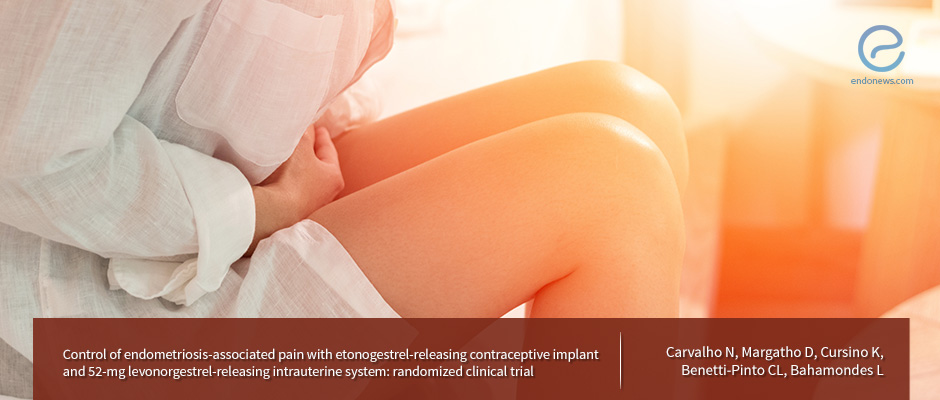Endometriosis-associated pain control by contraceptive implant or intrauterine system
Jan 21, 2019
Etonogestrel-releasing contraceptive implant and 52-mg levonorgestrel-releasing intrauterine system have similar therapeutic effects in women with endometriosis-associated pelvic pain.
Key Points
Highlights:
- Women with endometriosis experience improvement of endometriosis-associated noncyclic pelvic pain, dysmenorrhea, and health-related quality of life with similar efficacy using the etonogestrel-releasing contraceptive implant and 52-mg levonorgestrel-releasing intrauterine system.
Importance:
- Endometriosis-associated pelvic pain is an important issue for women with endometriosis due to the negative impact on quality of life.
What’s done here?
- This open-label, parallel-group and noninferiority randomized clinical trial performed in Brazil evaluate the patient satisfaction with an etonogestrel-releasing contraceptive implant and 52-mg levonorgestrel-releasing intrauterine system (n=51).
- Healthy, non-pregnant women between 18-45 years of age were included. A total of 103 women who met the criteria.
- All women were randomized using a computer program to receive either an etonogestrel-releasing contraceptive implant (n=52) or 52-mg levonorgestrel-releasing intrauterine system.
- All participants were requested to fill a pain score diary based on the visual analog scale (VAS) and Endometriosis Health Profile 30 (EHP-30) questionnaire to assess the status of noncyclic chronic pelvic pain and dysmenorrhea and health-related quality of life every 90-day reference periods.
- Bleeding patterns were also recorded as amenorrhea, infrequent bleeding, frequent bleeding, regular bleeding, prolonged bleeding and spotting at the 90-day follow-up visits.
Key results:
- There is no statistically significant difference between groups regarding their clinical and demographic characteristics.
- Both treatment methods resulted in similar improvements for endometriosis-associated noncyclic pelvic pain and dysmenorrhea and health-related quality of life.
- In the first 90-day period, the most common bleeding pattern was infrequent bleeding and spotting in women with the etonogestrel-releasing contraceptive implant and levonorgestrel-releasing intrauterine system, respectively.
- In the first 180-day period, the most common bleeding pattern was amenorrhea and infrequent bleeding in women with the etonogestrel-releasing contraceptive implant and levonorgestrel-releasing intrauterine system, respectively.
Strengths and Limitations
- The big sample size, randomized clinical trial design, and the inclusion of only women with histologically confirmed diagnosis represent the strengths of this study.
- Approximately 10% loss to follow-up, the short duration of follow-up, lack of blinding, and the absence of a placebo/control group were the limitations of this study.
Lay Summary
Endometriosis is defined as the localization of endometrial glandular and stromal cells outside the uterine cavity. The most common symptoms are dysmenorrhea, dyspareunia, and chronic pelvic pain, all of which affect the quality of women’s lives.
Several studies investigating the efficacy of levonorgestrel-releasing intrauterine system on endometriosis-associated pelvic pain have been performed. However, the etonogestrel-releasing contraceptive implant as an alternative for this purpose has not been adequately evaluated.
Carvalho et al., from Brazil, along with a group of scientists lead by Dr. Bahamondes, published a randomized clinical study entitled as “Control of endometriosis-associated pain with the etonogestrel-releasing contraceptive implant and 52-mg levonorgestrel-releasing intrauterine system: randomized clinical trial” in the journal named as Fertility and Sterility. The authors sought to compare the effectiveness of the etonogestrel-releasing contraceptive implant and the 52-mg levonorgestrel-releasing intrauterine system for the improvement of endometriosis-associated noncyclic pelvic pain, dysmenorrhea, and HRQoL in women with a surgically and histologically confirmed endometriosis.
They found that both treatment options are equally effective in the improvement of endometriosis-associated noncyclic pelvic pain, dysmenorrhea, and health-related quality of life.
“Further studies are required, particularly with respect to the ENG implant, to enable the long-term effects of this treatment to be assessed in a larger sample,” they added.
Research Source: https://www.ncbi.nlm.nih.gov/pubmed/?term=30396557
endometriosis etonogestrel-releasing contraceptive implant 52-mg levonorgestrel-releasing intrauterine system endometriosis-associated noncyclic pelvic pain dysmenorrhea health-related quality of life

